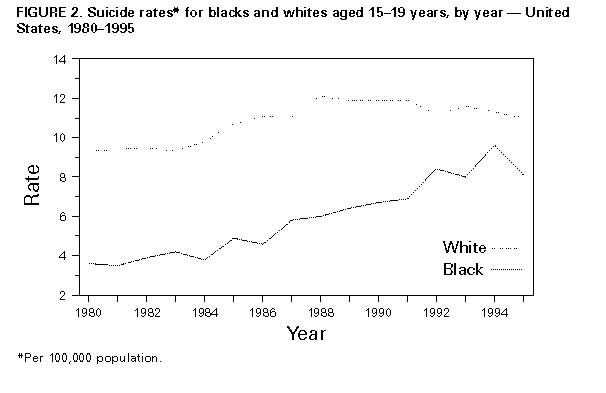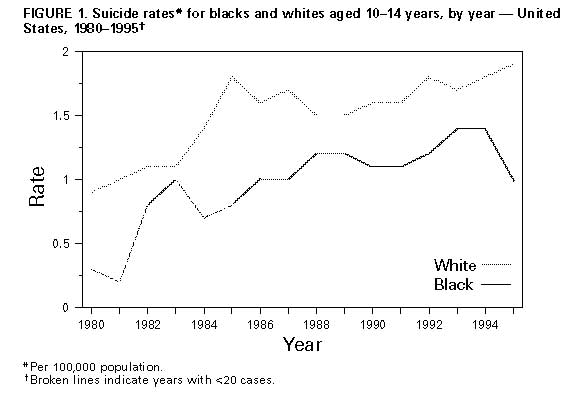|
Would a US Federal Agency Mislead the Public and Endanger Children to Protect a Cabinet Secretary's Feminist Agenda?
On March 20, 1998 newspaper readers in the United States were told of an alarming rise in the suicide rate among black youth. Under the headline "Suicide Rate of Young Blacks Up Dramatically", the Associated Press reported that "The suicide rate among black children and teen-agers in the United States more than doubled between 1980 and 1995, and one reason might be the stress of achieving middle-class success, the government said yesterday."
The "government" in this case was the Epidemiology Program Office of the Centers for Disease Control and Prevention in Atlanta, a unit of the Department of Health and Human Services. That office publishes Morbidity and Mortality Weekly Report, a journal of interest to medical researchers and epidemiologists, as part of its Scientific Communications efforts. MMWR, as it is called, is an unlikely place to encounter political spin control. Or so you'd think.
The press reports were based on an article in the March 20, 1998 issue of MMWR entitled Suicide Among Black Youths -- United States, 1980-1995. The article states that:
Strictly speaking, there are two inaccurate statements in that paragraph. It is not true that suicidal behavior among all youths has increased, and it is also not true that suicidal behavior among all blacks aged 10-19 years has increased. Suicide among black girls aged 10-19 has in fact gone down over the period. All of the rise which the CDC reports as occurring among "black youth" occurs among boys. A similar situation obtains among whites: the suicide rate among boys aged 10-14 has doubled over the period; among boys 15-19 it is up 30%. Among white girls aged 15-19, the suicide rate has not changed since 1980. There are so few suicides among girls aged 10-14, of either race, that percentage comparisons are meaningless.
However, in seeking to explain this phenomenon which affects boys but not girls, whether black or white, the MMWR takes the unlikely tack of going into elaborate explanations focusing on race:
It is hard to imagine how such factors as "entering the middle class" could explain a dramatic rise in suicide among "black youth" when the suicide rate among half of them, the girls, is going down.
Here is a graph of suicide rates among youths 15-19, exactly as it appeared in the MMWR:
Here is the same graph, but broken out by sex as well as race:
Here are comparable graphs for youths aged 10-14:
To make things as clear as possible, here is a graph of the trend lines, as computed by the least-squares regression method:
All data for these graphs is taken from the National Center for Health Statistics publication DEATH RATES FOR 72 SELECTED CAUSES, BY 5-YEAR AGE GROUPS, RACE, AND SEX: UNITED STATES, 1979-95 -- (RATES PER 100,000 POPULATION) which is available on line at: https://www.cdc.gov/nchs/data/mortab/291a_1.pdf
It is hard to look at these graphs and imagine that race is the determining factor in the rise of suicide among "youth". Quite clearly, regardless of race, suicide is increasing dramatically among boys... but not girls.
However, to say, as the MMWR did not say:
.... would run afoul of some other things that are going on in the office of Donna Shalala, the Secretary of Health and Human Services, to whom the CDC reports.
In remarks on May 1, 1997 in Los Angeles, before a group called Girls in the Media, Secretary Shalala had said:
Perhaps that is why, on October 15, 1997, the Department of Health and Human Services announced:
In its "Fact Sheet" describing the Department's "Girl Power!" self-esteem campaign (there is no Boy Power! self-esteem campaign), DHHS says:
Well, if the Secretary's office in Washington, D.C. says that the "research shows" that girls get depressed while boys get aggressive, and it's the girls we have to worry about committing suicide, we can't very well have mere statisticians down in the Epidemiology Office at CDC putting out reports that say otherwise.
Can we.
In the hopes that we were being unfair to the Secretary's office, we ran a search on the Department's web site:
It is a temporary file, and will expire about an hour after the search.
Searching /u3/waiscom/current/live/indexes/hhsweb...
Your query:
is equivalent to:
and was interpreted as:
The database contains 14,038,298 words in 15,186 documents.
There are 252,532 different words.
There are no fields in this database.
suicide occurs 178 times in 70 documents.
boys occurs 173 times in 58 documents.
The search found 8 documents. It took less than a second.
1)1997.05.28: (Fact Sheet) HHS Girl Power! Campaign
2)1997.05.01 : Girls in the Media, Los Angeles, California
3)1997.06.23 : National Meeting of Executive Directors, Girl Scouts of the U.S.A., Nashville, Tenne
4)1997.07.14 : Hadassah's 83rd Annual National Convention, Chicago, Illinois
5)1997.09.11: (Fact Sheet) Preventing Teenage Pregnancy
6)1997.03.28 : Press Conference to Release Report on Physical Activity and Sport in the Lives of Girls
7)California Department of Social Services, DAB No. 960 (1988)
8)1997.10.15 : HHS Awards $1 Million To Build Bright Futures For Young Girls We thought perhaps Secretary Shalala had said something about the suicide problem among boys at Hadassah's 83rd Annual National Convention, the fourth item on the list. So we checked:
PLACE: Hadassah's 83rd Annual National Convention, Chicago, Illinois
"Twenty-five years after we enacted Title IX, girls are still twice as likely as boys to be physically
inactive. They're more likely to be depressed. More likely to attempt suicide."
It is often said that any attention paid to the possibility that there might be male victims of domestic violence only takes away from the more serious problem affecting women. And perhaps the same may be said here. According to the article in the MMWR, "Firearm-related suicides accounted for 96% of the increase in the suicide rate for blacks aged 10-19 years." And as we have shown here, "Suicides among boys accounted for 100% of the increase in the suicide rate for blacks aged 10-19 years." It should be obvious now that if any attention is paid to the fact that suicide among boys is six times higher than among girls, and is rising much faster, that might threaten the funding for the Secretary's Girl Power! self-esteem campaign. And we can't have that, even if children are blowing their heads off with guns. |





